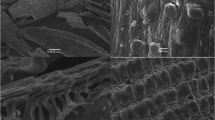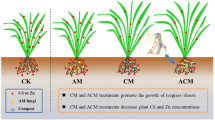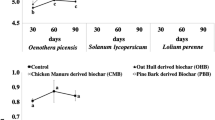Abstract
Soil metal contamination has emerged as a global environmental issue due to toxicity to living organisms. Traditional remediation techniques applied to metal-contaminated soils are intrusive and expensive, by which more environmental-friendly methods, such as phytoremediation, are necessary to remediate metal-contaminated soils. This study aimed to evaluate the combined effect of poultry manure compost (PMC) and indigenous arbuscular mycorrhizal (IM) fungi inoculation over copper (Cu) immobilization and the effectiveness of these elements promoting the plant growth and the soil microbial communities in a Cu-contaminated soil. A sandy Cu-contaminated soil (338 mg kg−1 of extractable Cu) was amended with PMC (2 and 4% w/w) in a pot experiment using the metallophyte Oenothera picensis. The plants were inoculated with the IM fungi isolated from the Cu-contaminated soils and grown for 3 months. PMC produced a liming effect, reduced the exchangeable Cu, and increased the amount of Cu-bound to organic and residual fractions. In addition, PMC also increased the biomass of O. picensis, which grew 8.5 times than the ones in unamended soil. Moreover, PMC incorporation stimulated soil microorganisms, increasing basal respiration and dehydrogenase activity modifying also the microbial community composition probably by reducing Cu availability and increasing carbon and nutrient sources to microorganism. On the contrary, the IM fungi inoculation reduced the plant biomass and increased the Cu translocation to the aboveground tissues. Therefore, the PMC is an effective amendment for remediating Cu-contaminated soils since it buffered soil pH, decreased Cu availability, supported the growth of O. picensis, and promoted mainly microbial activities in special shifting bacterial communities.





Similar content being viewed by others
References
Alef K, Nannipieri P (1995) Methods in applied soil microbiology and biochemistry. Academic Press Ltd, London
Anderson T, Domsch K (1990) Application of ecophysiological quotients (qCO2 and qD) on microbial biomasses from soils of different cropping histories. Soil Biol Biochem 22:251–255
Aponte H, Medina J, Butler B, Meier S, Cornejo P, Kuzyakov Y (2020a) Soil quality indices for metal(loid) contamination: an enzymatic perspective. Land Degrad Dev 31:2700–2719. https://doi.org/10.1002/ldr.3630
Aponte H, Meli P, Butler B, Paolini J, Matus F, Merino C, Cornejo P, Kuzyakov Y (2020b) Meta-analysis of heavy metal effects on soil enzyme activities. Sci Total Environ 737:139744. https://doi.org/10.1016/j.scitotenv.2020.139744
Aponte H, Herrera W, Cameron C, Black H, Meier S, Paolini J, Tapia Y, Cornejo P (2020c) Alteration of enzyme activities and functional diversity of a soil contaminated with copper and arsenic. Ecotoxicol. and Environ. Saf. 192:110264. https://doi.org/10.1016/j.ecoenv.2020.110264
Audet P, Charest C (2007) Dynamics of arbuscular mycorrhizal symbiosis in heavy metal phytoremediation: meta-analytical and conceptual perspectives. Environ Pollut 147:609–614. https://doi.org/10.1016/j.envpol.2006.10.006
Belyaeva ON, Haynes RJ (2012) Comparison of the effects of conventional organic amendments and biochar on the chemical, physical and microbial properties of coal fly ash as a plant growth medium. Environ Earth Sci 66:1987–1997. https://doi.org/10.1007/s12665-011-1424-y
Blagodatskaya Е, Kuzyakov Y (2008) Mechanisms of real and apparent priming effects and their dependence on soil microbial biomass and community structure: critical review. Biol Fertil Soils 45:115–131. https://doi.org/10.1007/s00374-008-0334-y
Bolan N, Kunhikrishnan A, Thangarajan R, Kumpiene J, Park J, Makino T, Kirkham MB, Scheckel K (2014) Remediation of heavy metal(loid)s contaminated soils – to mobilize or to immobilize? J Hazard Mater 266:141–166. https://doi.org/10.1016/j.jhazmat.2013.12.018
Bonfante P, Anca I-A (2009) Plants, mycorrhizal fungi, and bacteria: a network of interactions. Annu Rev Microbiol 63:363–383. https://doi.org/10.1146/annurev.micro.091208.073504
Carrera LM, Buyer JS, Vinyard B, Abdul-Baki AA, Sikora LJ, Teasdale JR (2007) Effects of cover crops, compost, and manure amendments on soil microbial community structure in tomato production systems. Appl Soil Ecol 37:247–255. https://doi.org/10.1016/j.apsoil.2007.08.003
Christie P, Li X, Chen B (2004) Arbuscular mycorrhiza can depress translocation of zinc to shoots of host plants in soils moderately polluted with zinc. Plant Soil 261:209–217. https://doi.org/10.1023/B:PLSO.0000035542.79345.1b
Cookson WR, Osman M, Marschner P, Abaye DA, Clark I, Murphy DV, Stockdale EA, Watson CA (2007) Controls on soil nitrogen cycling and microbial community composition across land use and incubation temperature. Soil Biol Biochem 39:744–756. https://doi.org/10.1016/j.soilbio.2006.09.022
Cornejo P, Meier S, Borie G, Rillig MC, Borie F (2008) Glomalin-related soil protein in a Mediterranean ecosystem affected by a copper smelter and its contribution to Cu and Zn sequestration. Sci Total Environ 406:154–160. https://doi.org/10.1016/j.scitotenv.2008.07.045
Cornejo P, Pérez-Tienda J, Meier S, Valderas A, Borie F, Azcón-Aguilar C, Ferrol N (2013) Copper compartmentalization in spores as a survival strategy of arbuscular mycorrhizal fungi in Cu-polluted environments. Soil Biol Biochem 57:925–928. https://doi.org/10.1016/j.soilbio.2012.10.031
DalCorso G, Fasani E, Manara A, Visioli G, Furini A (2019) Heavy metal pollutions: state of the art and innovation in phytoremediation. Int J Mol Sci 20:3412. https://doi.org/10.3390/ijms20143412
Del Val C, Barea JM, Azcón-Aguilar C (1999) Diversity of arbuscular mycorrhizal fungus populations in heavy-metal-contaminated soils. Appl Environ Microbiol 65:718–723. https://doi.org/10.1128/AEM.65.2.718-723.1999
Durán P, Tortella G, Viscardi S, Barra PJ, Carrión VJ, De La Luz MM, Pozo MJ (2018) Microbial community composition in take-all suppressive soils. Front Microbiol 9:2198. https://doi.org/10.3389/fmicb.2018.02198
Eissa MA (2019) Effect of compost and biochar on heavy metals phytostabilization by the halophytic plant old man saltbush [Atriplex Nummularia Lindl]. Soil Sediment Contam 28:135–147. https://doi.org/10.1080/15320383.2018.1551325
Ferrol N, González-Guerrero M, Valderas A, Benabdellah K, Azcón-Aguilar C (2009) Survival strategies of arbuscular mycorrhizal fungi in Cu-polluted environments. Phytochem Rev 8:551–559. https://doi.org/10.1007/s11101-009-9133-9
Giovannetti M, Mosse B (1980) An evaluation of techniques for measuring vesicular-arbuscular mycorrhizal infection in roots. New Phytol 84:489–500
González I, Muena V, Cisternas M, Neaman A (2008) Acumulación de cobre en una comunidad vegetal afectada por contaminación minera en el valle de Puchuncaví, Chile central. Rev Chil Hist Nat 81:279–291. https://doi.org/10.4067/S0716-078X2008000200010 (in Spanish)
Hassan SE, Hijri M, St-Arnaud M (2013) Effect of arbuscular mycorrhizal fungi on trace metal uptake by sunflower plants grown on cadmium contaminated soil. N Biotechnol 30:780–787. https://doi.org/10.1016/j.nbt.2013.07.002
He Y, mei, Yang R, Lei G, Li B, Jiang M, Yan K, Zu Y qun, Zhan F dong, Li Y, (2020) Arbuscular mycorrhizal fungi reduce cadmium leaching from polluted soils under simulated heavy rainfall. Environ Pollut 263. https://doi.org/10.1016/j.envpol.2020.114406
Hildebrandt U, Regvar M, Bothe H (2007) Arbuscular mycorrhiza and heavy metal tolerance. Phytochemistry 68:139–146. https://doi.org/10.1016/j.phytochem.2006.09.023
Igalavithana AD, Lee SE, Lee YH, Tsang DCW, Rinklebe J, Kwon EE, Ok YS (2017) Heavy metal immobilization and microbial community abundance by vegetable waste and pine cone biochar of agricultural soils. Chemosphere 174:593–603. https://doi.org/10.1016/j.chemosphere.2017.01.148
Iwamoto T, Tani K, Nakamura K, Suzuki Y, Kitagawa M, Eguchi M, Nasu M (2000) Monitoring impact of in situ biostimulation treatment on groundwater bacterial community by DGGE. FEMS Microb Ecol 32:129–141
Janoušková M, Pavlíková D, Vosátka M (2006) Potential contribution of arbuscular mycorrhiza to cadmium immobilisation in soil. Chemosphere 65:1959–1965. https://doi.org/10.1016/j.chemosphere.2006.07.007
Khan AG (2006) Mycorrhizoremediation--an enhanced form of phytoremediation. J Zhejiang Univ Sci B 7:503–514. https://doi.org/10.1631/jzus.2006.B0503
Khodadad CLM, Zimmerman AR, Green SJ, Uthandi S, Foster JS (2011) Taxa-specific changes in soil microbial community composition induced by pyrogenic carbon amendments. Soil Biol Biochem 43:385–392
Klassen SP, McLean JE, Grossl PR, Sims RC (2000) Fate and behavior of lead in soils planted with metal-resistant species (river birch and smallwing sedge). J Environ Qual 29:1826–1834. https://doi.org/10.2134/jeq2000.00472425002900060013x
Lam EJ, Cánovas M, Gálvez ME, Montofré ÍL, Keith BF, Faz Á (2017) Evaluation of the phytoremediation potential of native plants growing on a copper mine tailing in northern Chile. J Geochem Explor 182:210–217. https://doi.org/10.1016/J.GEXPLO.2017.06.015
Lauber CL, Hamady M, Knight R, Fierer N (2009) Pyrosequencing-based assessment of soil pH as a predictor of soil bacterial community structure at the continental scale. Appl Environ Microbiol 75:5111–5120. https://doi.org/10.1128/AEM.00335-09
Liang J, Yang Z, Tang L, Zeng G, Yu M, Li X, Wu H, Qian Y, Li X, Luo Y (2017) Changes in heavy metal mobility and availability from contaminated wetland soil remediated with combined biochar-compost. Chemosphere 181:281–288. https://doi.org/10.1016/j.chemosphere.2017.04.081
Mahar A, Wang P, Ali A, Awasthi MK, Lahori AH, Wang Q, Li R, Zhang Z (2016) Challenges and opportunities in the phytoremediation of heavy metals contaminated soils: a review. Ecotoxicol Environ Saf 126:111–121. https://doi.org/10.1016/j.ecoenv.2015.12.023
McIntosh JL (1969) Bray and Morgan soil test extractants modified for testing acid soils from different parent materials. Agron J 61:259–265
Medina J, Monreal C, Chabot D, Meier S, González ME, Morales E, Parillo R, Borie F, Cornejo P (2017) Microscopic and spectroscopic characterization of humic substances from a compost amended copper contaminated soil: main features and their potential effects on Cu immobilization. Environ Sci Pollut Res 24:14104–14116. https://doi.org/10.1007/s11356-017-8981-x
Meier S, Azcón R, Cartes P, Borie F, Cornejo P (2011) Alleviation of Cu toxicity in Oenothera picensis by copper-adapted arbuscular mycorrhizal fungi and treated agrowaste residue. Appl Soil Ecol 48:117–124. https://doi.org/10.1016/j.apsoil.2011.04.005
Meier S, Alvear M, Borie F, Aguilera P, Ginocchio R, Cornejo P (2012a) Influence of copper on root exudate patterns in some metallophytes and agricultural plants. Ecotoxicol Environ Saf 75:8–15. https://doi.org/10.1016/j.ecoenv.2011.08.029
Meier S, Borie F, Bolan N, Cornejo P (2012b) Phytoremediation of metal-polluted soils by arbuscular mycorrhizal fungi. Crit Rev Environ Sci Technol 42:741–775. https://doi.org/10.1080/10643389.2010.528518
Meier S, Borie F, Curaqueo G, Bolan N, Cornejo P (2012c) Effects of arbuscular mycorrhizal inoculation on metallophyte and agricultural plants growing at increasing copper levels. Appl Soil Ecol 61:280–287. https://doi.org/10.1016/j.apsoil.2011.10.018
Meier S, Cornejo P, Cartes P, Borie F, Medina J, Azco R (2015) Interactive effect between Cu-adapted arbuscular mycorrhizal fungi and biotreated agrowaste residue to improve the nutritional status of Oenothera picensis growing in Cu-polluted soils. 126–135
Meier S, Curaqueo G, Khan N, Bolan N, Cea M, Eugenia GM, Cornejo P, Ok YS, Borie F (2017a) Chicken-manure-derived biochar reduced bioavailability of copper in a contaminated soil. J Soils Sediments 17:741–750. https://doi.org/10.1007/s11368-015-1256-6
Meier S, Curaqueo G, Khan N, Bolan N, Rilling J, Vidal C, Fernández N, Acuña J, González ME, Cornejo P, Borie F (2017b) Effects of biochar on copper immobilization and soil microbial communities in a metal-contaminated soil. J Soils Sediments 17:1237–1250. https://doi.org/10.1007/s11368-015-1224-1
Meier S, Moore F, González ME, Medina J, Campos P, Khan N, Cumming J, Sanhueza M, Mejías J, Morales A, Hirzel J, Seguel A (2019) Effects of three biochars on copper immobilization and soil microbial communities in a metal-contaminated soil using a metallophyte and two agricultural plants. Environ Geochem Health 43:1441–1456. https://doi.org/10.1007/s10653-019-00436-x
Moore F, González M-E, Khan N, Curaqueo G, Sanchez-Monedero M, Rilling J, Morales E, Panichini M, Mutis A, Jorquera M, Mejias J, Hirzel J, Meier S (2018) Copper immobilization by biochar and microbial community abundance in metal-contaminated soils. Sci Total Environ 616–617:960–969. https://doi.org/10.1016/j.scitotenv.2017.10.223
Newman EI (1966) A method of estimating the Total length of root in a sample. J Appl Ecol 3:139. https://doi.org/10.2307/2401670
Pardo T, Bernal MP, Clemente R (2014) Efficiency of soil organic and inorganic amendments on the remediation of a contaminated mine soil: I. Effects on trace elements and nutrients solubility and leaching risk. Chemosphere 107:121–128. https://doi.org/10.1016/j.chemosphere.2014.03.023
Park JH, Choppala GK, Bolan NS, Chung JW, Chuasavathi T (2011) Biochar reduces the bioavailability and phytotoxicity of heavy metals. Plant Soil 348:439–451. https://doi.org/10.1007/s11104-011-0948-y
Pérez R, Tapia Y, Antilén M, Casanova M, Vidal C, Santander C, Aponte H, Cornejo P (2021) Interactive effect of compost application and inoculation with the fungus Claroideoglomus claroideum in Oenothera picensis plants growing in mine tailings. Ecotoxicol Environ Saf 208:111495. https://doi.org/10.1016/j.ecoenv.2020.111495
Purakayastha TJ, Mandal A, Kumari S (2017) Phytoremediation of metal- and salt-affected soils. In: Bioremediation of salt affected soils: an Indian perspective. Springer International Publishing, Cham, pp 211–231
Rubio R, Borie F, Schalchli C, Castillo C, Azcón R (2003) Occurrence and effect of arbuscular mycorrhizal propagules in wheat as affected by source and amount of phosphorus fertilizer and fungal inoculation. Appl Soil Ecol 23:245–255
Sadzawka A, Carrasco M, Grez R, de la Luz MM (2005) Métodos de análisis de compost., Serie Acta. Instituto de Investigaciones Agropecuarias, Santiago, Chile (in Spanish)
Saha JK, Selladurai R, Coumar MV, Dotaniya ML, Kundu S, Patra AK (2017) Remediation and management of polluted sites. Springer Singapore, Singapore, pp 317–372
Sieverding E (1991) Vesicular-arbuscular mycorrhiza management in tropical agroecosystem. Deutshe Gesellschaft Technische Zusammenarbeit (GTZ) GmbH, Eschborn
Singh G, Pankaj U, Chand S, Verma RK (2019) Arbuscular mycorrhizal fungi-assisted phytoextraction of toxic metals by Zea mays L. from tannery sludge. Soil Sediment Contam 28:729–746. https://doi.org/10.1080/15320383.2019.1657381
Steiner C, Melear N, Harris K, Das KC (2011) Biochar as bulking agent for poultry litter composting. Carbon Manag 2:227–230. https://doi.org/10.4155/cmt.11.15
Strachel R, Wyszkowska J (2017) The role of compost in stabilizing the microbiological and biochemical properties of zinc-stressed soil. https://doi.org/10.1007/s11270-017-3539-6
Tan KH (2005) Soil sampling, preparation, and analysis, Second edn. CRC Press, Boca Raton, FL
Tessier A, Campbell PGC, Bisson M (1979) Sequential extraction procedure for the speciation of particulate trace metals. Anal Chem 51:844–851. https://doi.org/10.1021/ac50043a017
Thangarajan R, Bolan NS, Tian G, Naidu R, Kunhikrishnan A (2013) Role of organic amendment application on greenhouse gas emission from soil. Sci Total Environ 465:72–96. https://doi.org/10.1016/j.scitotenv.2013.01.031
Tiwari J, Ma Y, Bauddh K (2020) Arbuscular mycorrhizal fungi: an ecological accelerator of phytoremediation of metal contaminated soils. Arch Agron Soil Sci 0: https://doi.org/10.1080/03650340.2020.1829599
Trotta A, Falaschi P, Cornara L, Minganti V, Fusconi A, Drava G, Berta G (2006) Arbuscular mycorrhizae increase the arsenic translocation factor in the As hyperaccumulating fern Pteris vittata L. Chemosphere 65:74–81. https://doi.org/10.1016/j.chemosphere.2006.02.048
Vivas A, Biró B, Ruíz-Lozano JM, Barea JM, Azcón R (2006) Two bacterial strains isolated from a Zn-polluted soil enhance plant growth and mycorrhizal efficiency under Zn-toxicity. Chemosphere 62:1523–1533. https://doi.org/10.1016/j.chemosphere.2005.06.053
Xu T, Lou LP, Luo L, Cao RK, Duan DC, Chen YX (2012) Effect of bamboo biochar on pentachlorophenol leachability and bioavailability in agricultural soil. Sci Total Environ 414:727–731. https://doi.org/10.1016/j.scitotenv.2011.11.005
Zhang X, Wang H, He L, Lu K, Sarmah A, Li J, Bolan NS, Pei J, Huang H (2013) Using biochar for remediation of soils contaminated with heavy metals and organic pollutants. Environ Sci Pollut Res 20:8472–8483. https://doi.org/10.1007/s11356-013-1659-0
Acknowledgements
The authors also acknowledge Peats Group Ltd for providing the compost for this study.
Funding
This work received support from the FONDECYT 11150480 and 1170264 grants.
Author information
Authors and Affiliations
Corresponding author
Ethics declarations
Conflict of Interest
The authors declare no competing interests.
Additional information
Publisher’s note
Springer Nature remains neutral with regard to jurisdictional claims in published maps and institutional affiliations.
Supplementary Information
ESM 1
(DOCX 18 kb)
Rights and permissions
About this article
Cite this article
Meier, S., Moore, F., Khan, N. et al. Effect of Poultry Manure Compost and Arbuscular Mycorrhizal Fungi on Cu Immobilization and Soil Microbial Communities in a Cu-Contaminated Soil Using the Metallophyte Oenothera Picensis. J Soil Sci Plant Nutr 21, 1957–1967 (2021). https://doi.org/10.1007/s42729-021-00493-1
Received:
Accepted:
Published:
Issue Date:
DOI: https://doi.org/10.1007/s42729-021-00493-1




